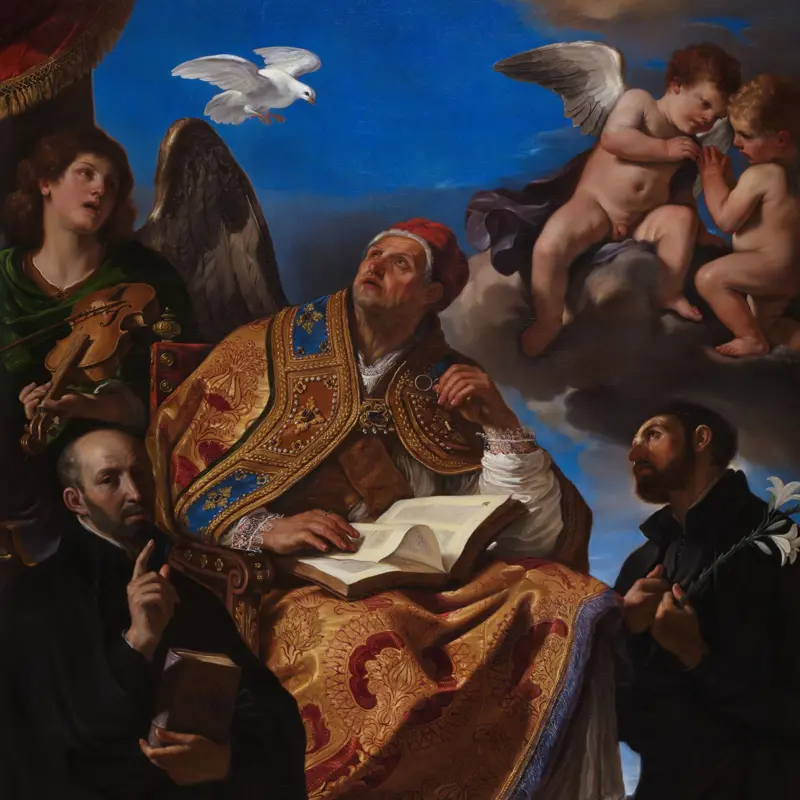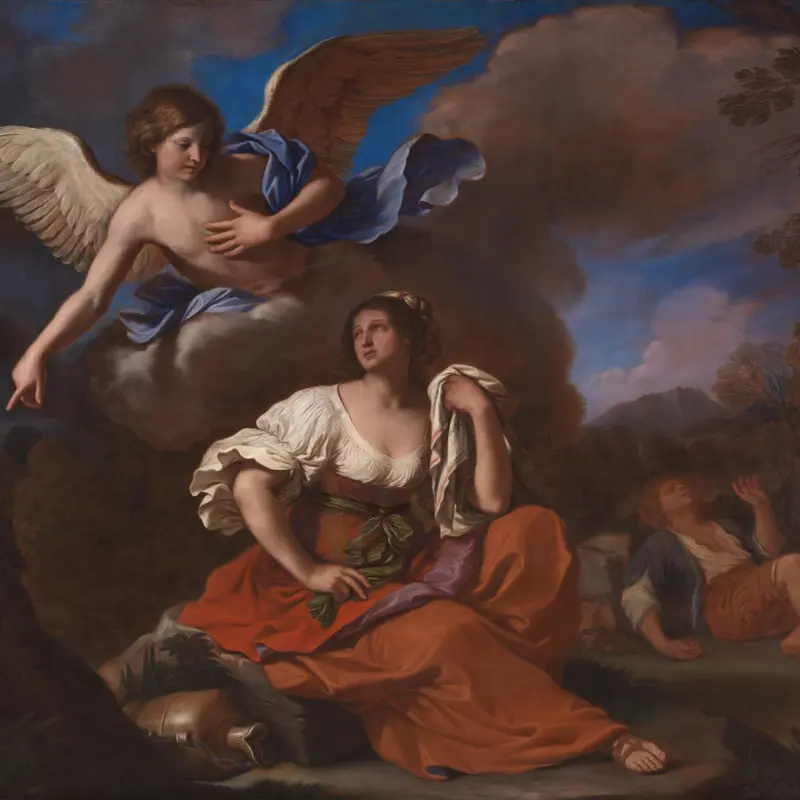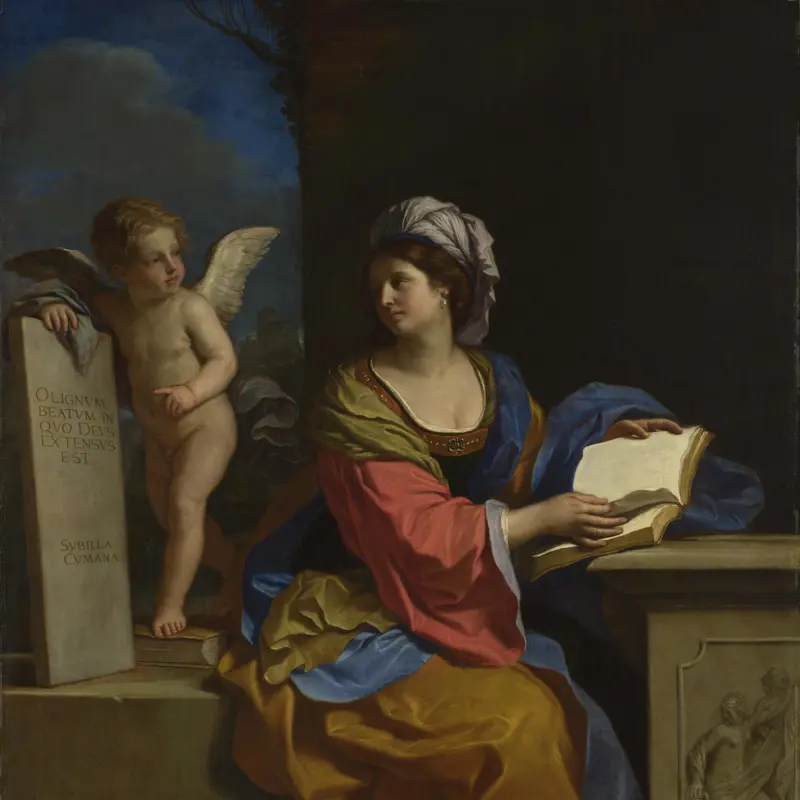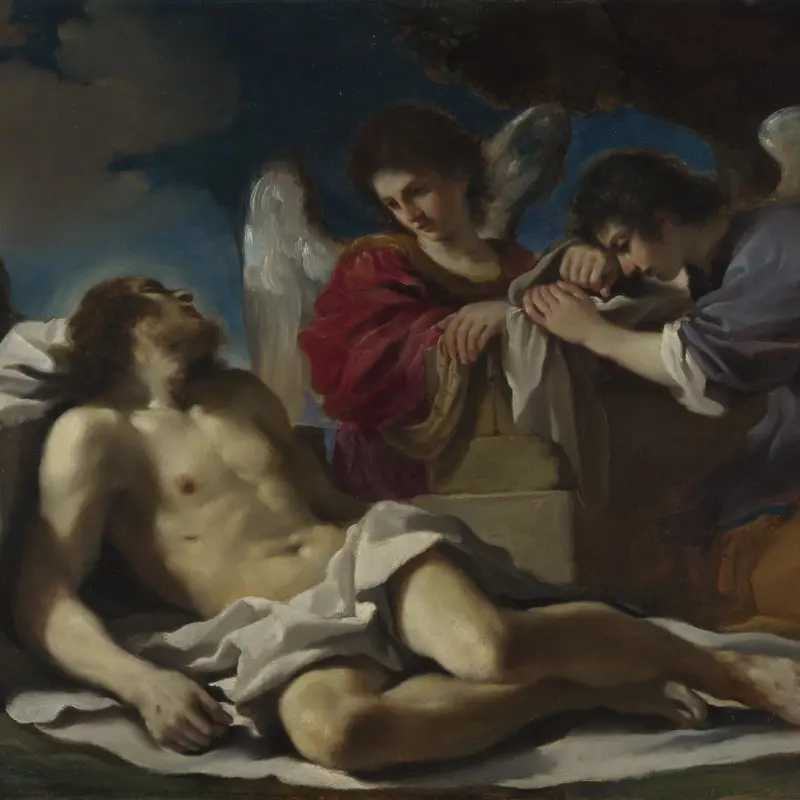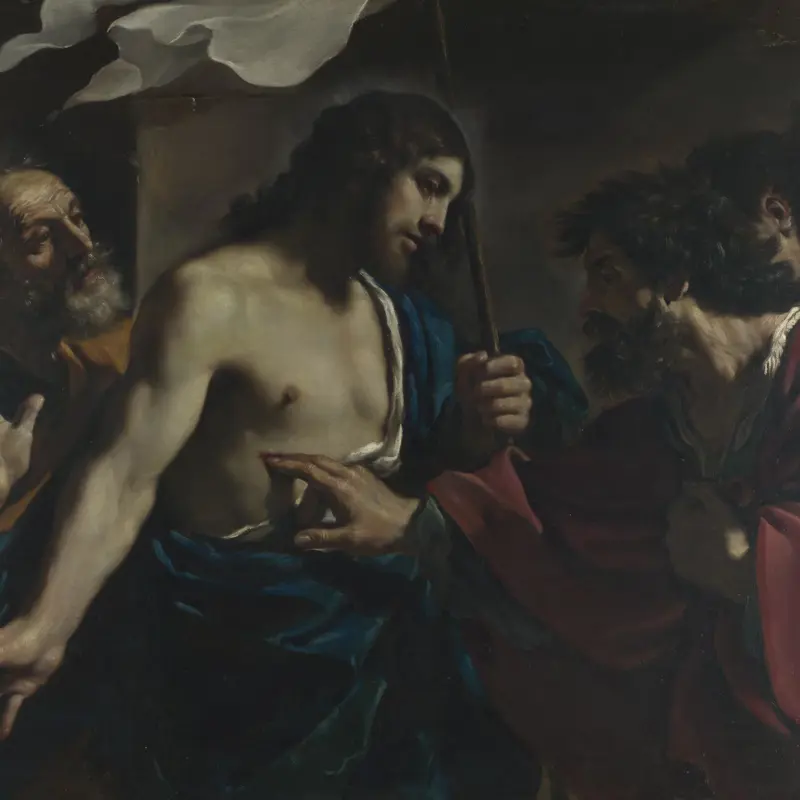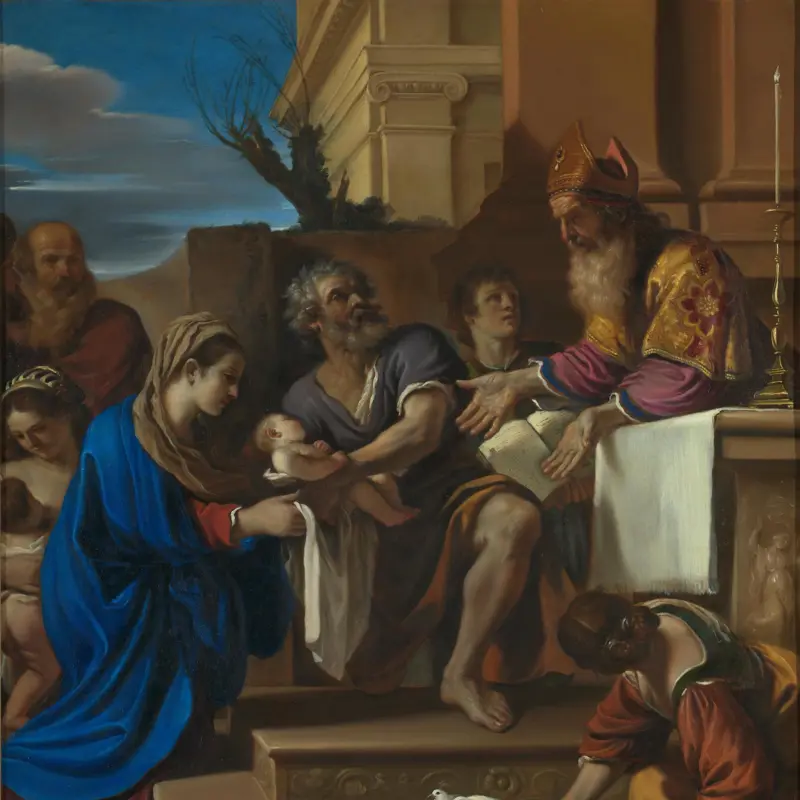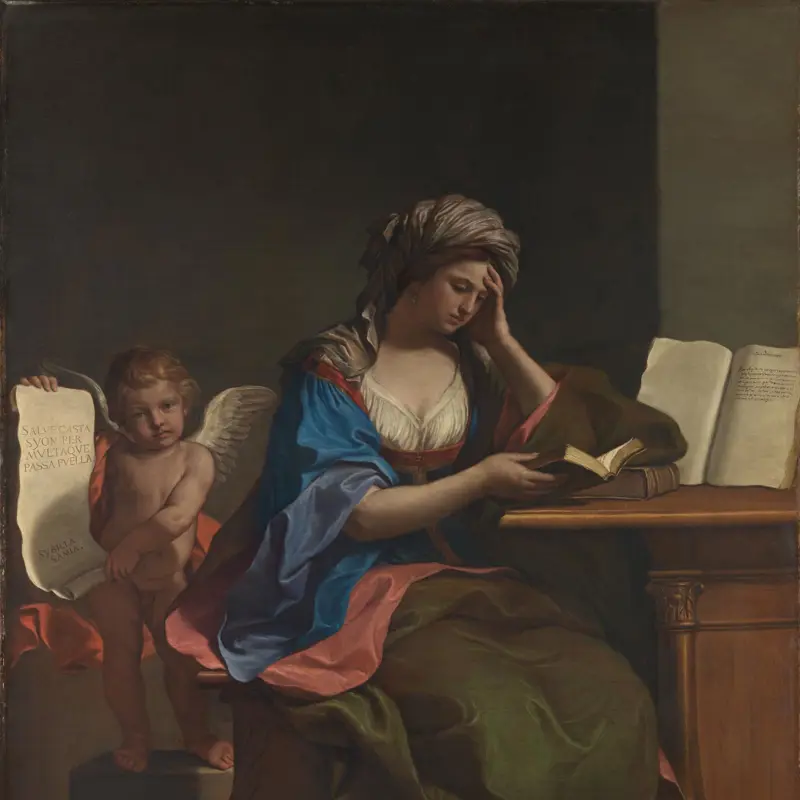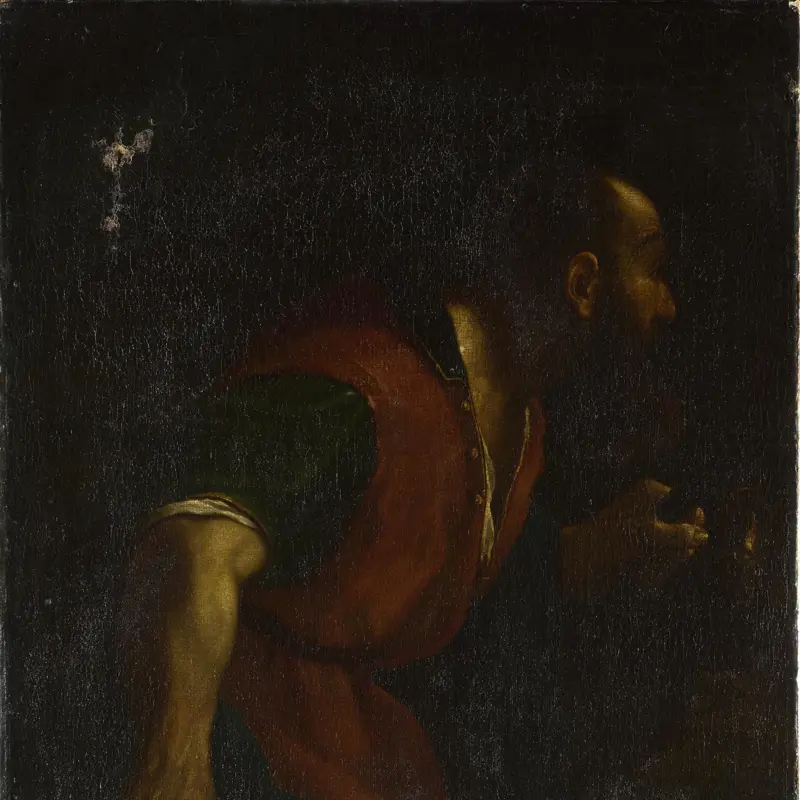Guercino, 'Elijah fed by Ravens', 1620
About the work
Overview
The monumental figure in this painting is Elijah, an Old Testament prophet who lived in Israel in the ninth century BC. Having predicted that a terrible drought would ravage the land, Elijah was instructed by God to hide by the stream Cherith. Here, ravens delivered bread and meat to him every morning and evening.
While Elijah’s story embodies piety, Guercino’s representation is profoundly human. The prophet sits awkwardly, his aged face turned expectantly toward the birds above him; they represent both physical and spiritual nourishment as Elijah places his faith in God’s commands. A bowl lies empty at his feet and his clothing is torn at the shoulder – reminders of his hunger and hardship in the wilderness.
This is one of two paintings Guercino made in 1620 for the papal legate of Ferrara, Cardinal Jacopo Serra, an early and enthusiastic patron of the artist.
Key facts
Details
Provenance
Additional information
Text extracted from the National Gallery’s Annual Report, ‘The National Gallery: Review of the Year, April 2009 – March 2010’.
Bibliography
-
1678C.C. Malvasia, Felsina pittrice: Vite de' pittori bolognesi, Bologna 1678
-
1830E. Platner et al., Beschreibung der Stadt Rom, 3 vols, Stuttgart-Tübingen 1830
-
1841C.C. Malvasia, Felsina pittrice: Vite de' pittori bolognesi del conte Carlo Cesare Malvasia, ed. G.P. Zanotti, Bologna 1841
-
1843J. Donovan, Rome, Ancient and Modern, Rome 1843
-
1922H. Voss, 'Guercino', in U. Thieme and F. Becker (eds), Allgemeines Lexikon der bildenden Künstler von der Antike bis zur Gegenwart, Leipzig 1922
-
1938Catalogue of the Exhibition of 17th Century Art in Europe, London 1938
-
1947D. Mahon, Studies in Seicento Art and Theory, London 1947
-
1953G. Briganti, 'The Mahon Collection of Seicento Paintings', The Connoisseur, CXXXII, 1953, pp. 4-18
-
1955E.K. Waterhouse, Exhibition of Italian Art from the 13th Century to the 17th Century (exh. cat. Birmingham CMuseum and Art Gallery, 18 August - 2nd October 1955), Birmingham 1955
-
1958R. Wittkower, Art and Architecture in Italy 1600-1750, Harmondsworth 1958
-
1960E.K. Waterhouse et al., Italian Art and Britain (exh. cat. Royal Academy of Arts, Winter 1960), London 1960
-
1963B. Nicolson, 'Denis Mahon', in D. Cooper (ed.), Great Private Collections, London 1963, pp. 116-25
-
1968D. Mahon, Il Guercino: Catalogo critico dei dipinti (exh. cat. Palazzo dell'Archiginnasio, 1 September - 18 November 1968), Bologna 1968
-
1971F. Vivian, 'Guercino as N from the Archivio Barberini', The Burlington Magazine, CXXIII/814, 1971, pp. 22-9
-
1975M.A. Lavin, Seventeenth-Century Barberini Documents and Inventories of Art, New York 1975
-
1981D. Mahon, 'Guercino and Cardinal Serra: A Newly Discovered Masterpiece', Apollo, CXIV, 1981, pp. 170-5
-
1986M. Aspinwall et al., The Age of Correggio and the Carracci: Emilian Painting of the Sixteenth and Seventeenth Centuries (exh. cat. National Gallery of Art, Washington, 19 December 1986 - 16 February 1987; Pinacoteca Nazionale, 10 September - 11 November 1986; Metropolitan Museum of Art, 26 March 26 - 24 May 1987), Washington 1986
-
1988L. Salerno, I dipinti del Guercino, Rome 1988
-
1991D.M. Stone, Guercino: Catalogo completo dei dipinti, Florence 1991
-
1991W.M. Griswold, 'Guercino', Metropolitan Museum of Art Bulletin, XLVIII/4, 1991, pp. 1-56
-
1991S. Ebert-Schifferer (ed.), Il Guercino (exh. cat. Schirn Kunsthalle, 3 December 1991 - 9 February 1992), Frankfurt 1991
-
1991M. Helston et al., Guercino in Britain: Paintings from British Collections (exh. cat. The National Gallery, 28 June - 31 July 1991), London 1991
-
1991D. Mahon, Giovanni Francesco Barbieri, Il Guercino, 1591-1666 (exh. cat. Museo civico archeologico, 6 July - 10 November 1991; Schirn Kunsthalle, 2 December 1991 - 9 February 1992; National Gallery of Art, Washington, 15 March - 17 May 1992), Bologna 1991
-
1997G. Finaldi et al., Discovering the Baroque: The Denis Mahon Collection (exh. cat. The National Gallery, 26 February - 18 May 1997), London 1997
-
1999S. Perlove, 'Power and Religious Authority in Papal Ferrara: Cardinal Serra and Guercino', Konsthistorisk Tidskrift, LXVII/1, 1999, pp. 19-30
-
2001
C. Baker and T. Henry, The National Gallery: Complete Illustrated Catalogue, London 2001
-
2004D. Mahon et al., Guercino: Poesia e sentimento nella pittura del'600 (exh. cat. Palazzo Reale (Milan), 27 September 2003 - 18 January 2004), Milan 2004
-
2005N. Turner, 'An Unpublished Drawing by Guercino for Elijah in the Desert Fed by Ravens', Master Drawings, XLIII/4, 2005, pp. 508-11
-
2005M. Pulini, Nel segno di Guercino: Disegni dalle collezioni Mahon, Oxford e Cento (exh. cat. Pinacoteca Civica, 28 May - 31 July 2005; Ashmolean Museum, 2 November 2005 - 16 January 2006), Cento 2005
-
2010National Gallery, The National Gallery: Review of the Year, April 2009 - March 2010, London 2010
About this record
If you know more about this work or have spotted an error, please contact us. Please note that exhibition histories are listed from 2009 onwards. Bibliographies may not be complete; more comprehensive information is available in the National Gallery Library.


